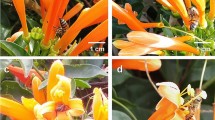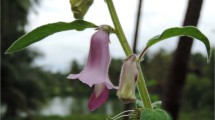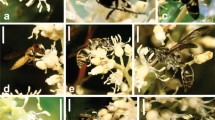Abstract
As “exploiters” of plant-pollinator mutualisms, nectar-robbers remove rewards (nectar) without providing pollination services. Though one might expect nectar-robbing to be costly to plants, it may instead benefit plants by indirectly increasing pollen dispersal. I investigated the direct effects of nectar-robbing bees (Xylocopa californica) on floral rewards and behaviors of pollinators visiting desert willow (Chilopsis linearis) and indirect effects of robbing on the reproductive success of the plant. Nectar-robbers reduced nectar; while unrobbed and robbed flowers were equally likely to contain nectar, nectar volumes were smaller in robbed flowers with nectar. Apis mellifera (honeybees), ineffective pollinators in terms of pollen deposition, avoided robbed flowers. In contrast, Bombus sonorus (bumblebees), effective pollinators, did not avoid robbed flowers. While bumblebees tended to spend less time in robbed flowers, the time that they spent in flowers was not correlated with pollen deposition. Using powder mimicking pollen, I found that on some days, powder was dispersed farther or to more flowers from robbed flowers, indicating that robbing may sometimes benefit plants by increasing male reproductive success. Powder movement suggested that the effect of robbing on male reproductive success ranged from costly to beneficial. The outcome for flowers that were marked early each morning was a function of prevalence of robbing and abundances of effective pollinators, but not a function of spatial variability among trees in prevalence of robbing or the abundance of ineffective honeybees. Unlike powder dispersal, female reproductive success, measured by fruit set and the number of pollen tubes growing in styles, was not affected by robbing. Thus, robbers did not reduce plants’ female reproductive success either directly by damaging flowers or indirectly by reducing pollen deposition by pollinators. Overall, this study indicates that nectar-robbers were not often costly to plants, and sometimes even benefited plants.



Similar content being viewed by others
References
Adler LS (2000) The ecological significance of toxic nectar. Oikos 91:409–420
Agrawal AA, Rudgers J, Botsford LW, Cutler D, Gorin JB, Lundquist CJ, Spitzer BW, Swann AL (2000) Benefits and constraints on plant defense against herbivores: spines influence the legitimate and illegitimate flower visitors of yellow star thistle, Centaurea solstitialis L. (Asteraceae). Southwest Nat 45:1–5
Alexander MP (1980) A versatile stain for pollen, fungi, yeast, and bacteria. Stain Tech 55:13–18
Barrows, EM (1976) Nectar robbing and pollination of Lantana camara (Verbenaceae). Biotropica 8:132–135
Bronstein JL (1994) Conditional outcomes in mutualistic interactions. Trends Ecol Evol 9:214–217
Bronstein JL (2001a) The costs of mutualism. Am Zool 41:825–839
Bronstein JL (2001b) The exploitation of mutualisms. Ecol Lett 4:277–287
Brown JH, Kodric-Brown A, Whitham TG, Bond HW (1981) Competition between hummingbirds and insects for the nectar of two species of shrubs. Southwest Nat 26:133–145
Bshary R, Grutter AS (2002) Asymmetric cheating opportunities and partner control in a cleaner fish mutualism. Anim Behav 63:547–555
Bshary R, Schaffer D (2002) Choosy reef fish select cleaner fish that provide high-quality service. Anim Behav 63:557–564
Dafni A (1992) Pollination ecology. Oxford University Press, New York
Denison RF (2000) Legume sanctions and the evolution of symbiotic cooperation by rhizobia. Am Nat 156:567–576
Dukas R, Real LA (1993) Effects of recent experience on foraging decisions by bumble bees. Oecologia 94:244–246
Fenster CB (1991) Gene flow in Chamaechrista fasciculata (Leguminosae). Evolution 45:398–409
Ferriere R, Bronstein J, Rinaldi S, Law R, Gauduchon M (2002) Cheating and the evolutionary stability of mutualisms. Proc R Soc London B 269:773–780
Gentry AH (1974) Coevolutionary patterns in Central American Bignoniaceae. Ann Mo Bot Gard 61:728–759
Gentry AH (1990) Evolutionary patterns in neotropical Bignoniaceae. Mem NY Bot Gard 55:118–129
Heinrich B (1979) Bumblebee economics. Harvard University Press, Cambridge, Massachusetts
Humphries S, Addicott J (2000) Regulation of the mutualism between yuccas and yucca moths: intrinsic and extrinsic factors affecting flower retention. Oikos 89:329–339
Inouye DW (1983) The ecology of nectar robbing. In: Bentley B, Elias T (ed) The biology of nectaries. Columbia University Press, New York, pp 153–173
Irwin RE, Brody AK (1998) Nectar robbing in Ipomopsis aggregata: effects on pollinator behavior and plant fitness. Oecologia 116:519–527
Irwin RE, Maloof JE (2002) Variation in nectar robbing over time, space, and species. Oecologia 133:525–533
Irwin RE, Brody AK, Waser NM (2001) The impact of floral larceny on individuals, populations, and communities. Oecologia 129:161–168
Johnson NC, Graham JH, Smith FA (1997) Functioning of mycorrhizal associations along the mutualism-parasitism continuum. New Phytol 135:575–586
Klinkhamer PGL, de Jong TJ, Metz JAJ (1994) Why plants can be too attractive-a discussion of measures to estimate male fitness. J Ecol 82:191–194
Lara C, Ornelas JF (2001) Preferential nectar robbing of flowers with long corollas: experimental studies of two hummingbird species visiting three plant species. Oecologia 128:263–273
Letourneau DK (1991) Parasitism of ant-plant mutualisms and the novel case of Piper. In: Huxley CR Cutler DF (ed) Ant-plant interactions. Oxford University Press, Oxford, pp 390–396
Maloof JE, Inouye DW (2000) Are nectar robbers cheaters or mutualists? Ecology 81:2651–2661
Moritz RFA, Southwick EE (1992) Bees as superorganisms. Springer, Berlin Heidelberg New York
National Climate Data Center (NCDC; Updated 19 July 1999) http://lwf.ncdc.noaa.gov/oa/climate/online/coop-precip.html#intro. US On-line Monthly Precipitation Data for Cooperative and NWS Sites
Noë R, Hammerstein P (1994) Biological markets: supply and demand determine the effect of partner choice in cooperation, mutualism, and mating. Behav Ecol Sociobiol 35:1–11
Pellmyr O (1997) Stability of plant-animal mutualisms: keeping the benefactors at bay. Trends Plant Sci 2:408–409
Pellmyr O, Huth CJ (1994) Evolutionary stability of mutualism between yuccas and yucca moths. Nature 372:257–260
Pellmyr O, Leebens-Mack J, Huth CJ (1996) Non-mutualistic yucca moths and their evolutionary consequences. Nature 380:155–156
Richardson SC (1995) Temporal variation in pollinator abundance and pollinator foraging behavior in response to robbed flowers. In: DeBano LF, Ffolliott PF, Ortega-Rubio A, Gottfried GJ, Hamre RH, Edminster CB (ed) Biodiversity and management of the Madrean Archipelago: the Sky Islands of southwestern United States and northwestern Mexico. U.S. Department of Agriculture, Forest Service, Fort Collins, Colo., pp 311–316
Schwartz MW, Hoeksema JD (1998) Specialization and resource trade: biological markets as a model of mutualisms. Ecology 79:1029–1038
Stephenson AG (1982) Iridoid glycosides in the nectar of Catalpa speciosa are unpalatable to nectar thieves. J Chem Ecol 8:1025–1034
Stout JC, Goulson D (2001) The use of conspecific and interspecific scent marks by foraging bumblebees and honeybees. Anim Behav 62:183–189
Thomson JD, Price MV, Waser NM, Stratton DA (1986) Comparative studies of pollen and fluorescent dye transport by bumblebees visiting Erythronium grandiflorum. Oecologia 69:561–566
Whitham TG (1977) Coevolution of foraging in Bombus and nectar dispensing in Chilopsis: a last dreg theory. Science 197:593–596
Yu DW (2001) Parasites of mutualisms. Biol J Linn Soc 72:529–546
Acknowledgements
Financial support for this work came from two grants from the Theodore Roosevelt Memorial Fund of the American Museum of Natural History, by the 1994 Cranwell Smith Pollination Award from the University of Arizona, by the Southwestern Research Station Student Support Fund, and by grants from the Department of Ecology and Evolutionary Biology at the University of Arizona. The Knight family of Paradise, Ariz., the Ritchins families of Cotton City, N.M. and Animas, N.M., J. Caron of Crown Dancer Estates, M. Kraft, and A. and J. Dominic of Portal, Ariz. were kind in allowing research to be conducted on their land. I thank N. Plotkin, J. Chesnick, S. McGraw, P. Murphy, D. Banks, N. Compton, K. Toal, K. Spörns, A. Gove, and M. Brown for assistance in the field, and S. Buchmann for instruments, dye, and advice on techniques. The comments of J. Bronstein, L. McDade, J. Rudgers, R. Hudson, S. Kinsman, S. Forsyth, A. Boyle, J. Weeks, H. Harvey, H. Reynolds, T. Rajaniemi, and J. Bever improved this study and manuscript.
Author information
Authors and Affiliations
Corresponding author
Rights and permissions
About this article
Cite this article
Richardson, S.C. Are nectar-robbers mutualists or antagonists?. Oecologia 139, 246–254 (2004). https://doi.org/10.1007/s00442-004-1504-8
Received:
Accepted:
Published:
Issue Date:
DOI: https://doi.org/10.1007/s00442-004-1504-8




